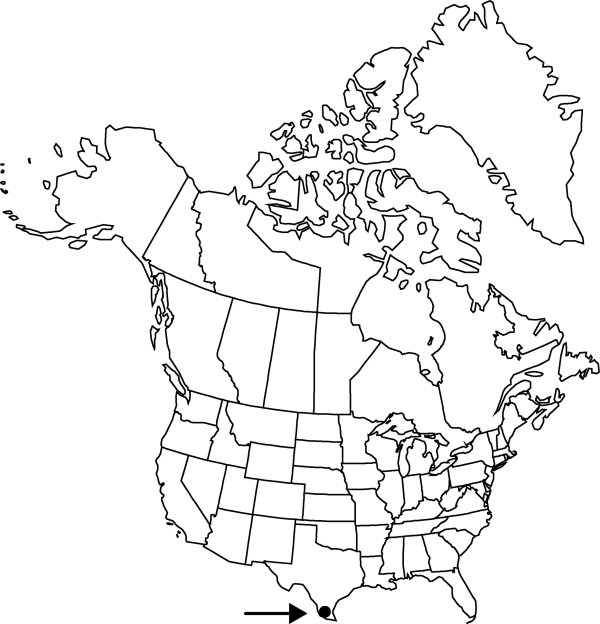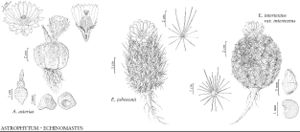Difference between revisions of "Astrophytum asterias"
Cactées, 50. 1868.
FNA>Volume Importer |
imported>Volume Importer |
||
| (7 intermediate revisions by 2 users not shown) | |||
| Line 8: | Line 8: | ||
}} | }} | ||
|common_names=Star-peyote;star cactus;se a-urchin cactus | |common_names=Star-peyote;star cactus;se a-urchin cactus | ||
| − | |basionyms={{Treatment/ID/ | + | |special_status={{Treatment/ID/Special_status |
| + | |code=F | ||
| + | |label=Illustrated | ||
| + | }}{{Treatment/ID/Special_status | ||
| + | |code=C | ||
| + | |label=Conservation concern | ||
| + | }} | ||
| + | |basionyms={{Treatment/ID/Basionym | ||
|name=Echinocactus asterias | |name=Echinocactus asterias | ||
|authority=Zuccarini | |authority=Zuccarini | ||
| + | |rank=species | ||
| + | |publication_title=Abh. Math.–Phys. Cl. Königl. Bayer. Akad. Wiss. | ||
| + | |publication_place=4(2): 13. 1845 | ||
}} | }} | ||
|synonyms= | |synonyms= | ||
| Line 20: | Line 30: | ||
}}<!-- | }}<!-- | ||
| − | --><span class="statement" id="st- | + | --><span class="statement" id="st-undefined" data-properties=""><b>Plants </b>flat-topped and usually flush with soil surface, or at most, above-ground portion low, dome-shaped. <b>Stems</b> shiny, sparsely speckled by bright white extra-areolar hair tufts 0.5–1 mm diam.; ribs usually 8, straight, very low, nearly flat or rounded; areoles 3–5 mm diam., with yellow or gray wool. <b>Flowers</b> opening widely, externally long woolly; inner tepals lanceolate, acuminate. <b>2n</b> = 22.</span><!-- |
-->{{Treatment/Body | -->{{Treatment/Body | ||
| + | |phenology=Flowering Mar–May and sporadically after summer rainfall. | ||
|habitat=Grasslands, shrublands, Tamaulipan thorn scrub, gravelly slopes and deep soil of flats | |habitat=Grasslands, shrublands, Tamaulipan thorn scrub, gravelly slopes and deep soil of flats | ||
|elevation=20-100 m | |elevation=20-100 m | ||
|distribution=Tex.;Mexico (Nuevo León;Tamaulipas). | |distribution=Tex.;Mexico (Nuevo León;Tamaulipas). | ||
|discussion=<p>Of conservation concern.</p><!-- | |discussion=<p>Of conservation concern.</p><!-- | ||
| − | --><p>The vernacular name of Astrophytum asterias, star-peyote, reflects its superficial similarity to peyote, Lophophora williamsii, which has very soft, uniformly pale blue-green stems quite unlike the hard, speckled, almost shiny, green stem surface in A. asterias. Astrophytum asterias is extremely rare and localized north of Mexico, presently known only from Starr County, Texas.</p> | + | --><p>The vernacular name of <i>Astrophytum asterias</i>, star-peyote, reflects its superficial similarity to peyote, <i>Lophophora williamsii</i>, which has very soft, uniformly pale blue-green stems quite unlike the hard, speckled, almost shiny, green stem surface in <i>A. asterias</i>. <i>Astrophytum asterias</i> is extremely rare and localized north of Mexico, presently known only from Starr County, Texas.</p> |
|tables= | |tables= | ||
|references= | |references= | ||
| Line 36: | Line 47: | ||
-->{{#Taxon: | -->{{#Taxon: | ||
name=Astrophytum asterias | name=Astrophytum asterias | ||
| − | |||
|authority=(Zuccarini) Lemaire | |authority=(Zuccarini) Lemaire | ||
|rank=species | |rank=species | ||
| Line 43: | Line 53: | ||
|basionyms=Echinocactus asterias | |basionyms=Echinocactus asterias | ||
|family=Cactaceae | |family=Cactaceae | ||
| + | |phenology=Flowering Mar–May and sporadically after summer rainfall. | ||
|habitat=Grasslands, shrublands, Tamaulipan thorn scrub, gravelly slopes and deep soil of flats | |habitat=Grasslands, shrublands, Tamaulipan thorn scrub, gravelly slopes and deep soil of flats | ||
|elevation=20-100 m | |elevation=20-100 m | ||
| Line 49: | Line 60: | ||
|publication title=Cactées, | |publication title=Cactées, | ||
|publication year=1868 | |publication year=1868 | ||
| − | |special status= | + | |special status=Illustrated;Conservation concern |
| − | |source xml=https:// | + | |source xml=https://bitbucket.org/aafc-mbb/fna-data-curation/src/2e0870ddd59836b60bcf96646a41e87ea5a5943a/coarse_grained_fna_xml/V4/V4_360.xml |
|subfamily=Cactaceae subfam. Cactoideae | |subfamily=Cactaceae subfam. Cactoideae | ||
|genus=Astrophytum | |genus=Astrophytum | ||
|species=Astrophytum asterias | |species=Astrophytum asterias | ||
| − | |||
| − | |||
| − | |||
| − | |||
| − | |||
| − | |||
| − | |||
| − | |||
| − | |||
| − | |||
| − | |||
| − | |||
| − | |||
| − | |||
| − | |||
| − | |||
| − | |||
| − | |||
}}<!-- | }}<!-- | ||
-->[[Category:Treatment]][[Category:Astrophytum]] | -->[[Category:Treatment]][[Category:Astrophytum]] | ||
Latest revision as of 22:58, 5 November 2020
Plants flat-topped and usually flush with soil surface, or at most, above-ground portion low, dome-shaped. Stems shiny, sparsely speckled by bright white extra-areolar hair tufts 0.5–1 mm diam.; ribs usually 8, straight, very low, nearly flat or rounded; areoles 3–5 mm diam., with yellow or gray wool. Flowers opening widely, externally long woolly; inner tepals lanceolate, acuminate. 2n = 22.
Phenology: Flowering Mar–May and sporadically after summer rainfall.
Habitat: Grasslands, shrublands, Tamaulipan thorn scrub, gravelly slopes and deep soil of flats
Elevation: 20-100 m
Distribution

Tex., Mexico (Nuevo León, Tamaulipas).
Discussion
Of conservation concern.
The vernacular name of Astrophytum asterias, star-peyote, reflects its superficial similarity to peyote, Lophophora williamsii, which has very soft, uniformly pale blue-green stems quite unlike the hard, speckled, almost shiny, green stem surface in A. asterias. Astrophytum asterias is extremely rare and localized north of Mexico, presently known only from Starr County, Texas.
Selected References
None.
